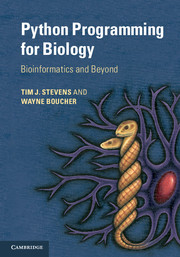Book contents
- Frontmatter
- Contents
- Preface
- Acknowledgements
- 1 Prologue
- 2 A beginners’ guide
- 3 Python basics
- 4 Program control and logic
- 5 Functions
- 6 Files
- 7 Object orientation
- 8 Object data modelling
- 9 Mathematics
- 10 Coding tips
- 11 Biological sequences
- 12 Pairwise sequence alignments
- 13 Multiple-sequence alignments
- 14 Sequence variation and evolution
- 15 Macromolecular structures
- 16 Array data
- 17 High-throughput sequence analyses
- 18 Images
- 19 Signal processing
- 20 Databases
- 21 Probability
- 22 Statistics
- 23 Clustering and discrimination
- 24 Machine learning
- 25 Hard problems
- 26 Graphical interfaces
- 27 Improving speed
- Appendices
- Glossary
- Index
- Plate section
- References
14 - Sequence variation and evolution
Published online by Cambridge University Press: 05 February 2015
- Frontmatter
- Contents
- Preface
- Acknowledgements
- 1 Prologue
- 2 A beginners’ guide
- 3 Python basics
- 4 Program control and logic
- 5 Functions
- 6 Files
- 7 Object orientation
- 8 Object data modelling
- 9 Mathematics
- 10 Coding tips
- 11 Biological sequences
- 12 Pairwise sequence alignments
- 13 Multiple-sequence alignments
- 14 Sequence variation and evolution
- 15 Macromolecular structures
- 16 Array data
- 17 High-throughput sequence analyses
- 18 Images
- 19 Signal processing
- 20 Databases
- 21 Probability
- 22 Statistics
- 23 Clustering and discrimination
- 24 Machine learning
- 25 Hard problems
- 26 Graphical interfaces
- 27 Improving speed
- Appendices
- Glossary
- Index
- Plate section
- References
Summary
A basic introduction to sequence variation
Naturally the genetic codes of different kinds of organism differ to support their different construction, habits and biological requirements. Also, genetic codes vary between individuals of the same species, despite the large degree of similarity that binds them as a species. It is such variation within species that provides the opportunity for offspring to differ from their parents and potentially gain an improvement or specialisation, which in time may give rise to a new species. In a more modern context, sequence variations have a vital role in our understanding of genetic diseases and are becoming increasingly important for the development of pharmaceuticals, where the effectiveness and side effects of drugs may vary significantly according to the genotype of a person.
The variety of species and individuals is all down to the variety of genome sequences, but in order to discover as much as we can about the consequences of and reasons for this variation we should understand something about the mechanism by which sequences can change. In this chapter we will not go in to immense detail about the underlying mechanics, but simply cover the main principles and, importantly as far as bioinformatics is concerned, describe what kinds of change are detectable in the biological sequences. It should be remembered that it is only changes that are passed on to offspring which will influence evolution directly, but other variations may be important, for example, in the study of cancer-causing mutations.
- Type
- Chapter
- Information
- Python Programming for BiologyBioinformatics and Beyond, pp. 244 - 277Publisher: Cambridge University PressPrint publication year: 2015



